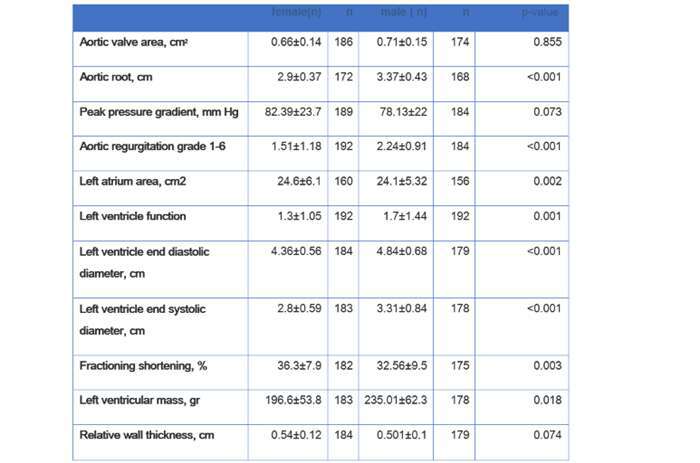Background: Aortic-valve stenosis (AS), is the most common valvular heart disease of the elderly. With the change in life expectancy this prevalence will be higher. There is only few data regarding the gender differences in patients with AS.
Objective: We investigated the gender differences in echocardiography measurements and cardiac adaptation to pressure overload in men and women with severe AS.
Methods: A cross sectional study was performed. Data was collected from the laboratory of echocardiography at Rabin Medical Center. The study group included all patients with severe AS that were examined during 2005 to 2010. After all exclusions 192 men and 192 women were studied. All measurement were adjusted to BSA The following measurements were compared: aortic valve area (AVA), aortic root and ascending aorta diameters , mean and peak aortic gradients, systolic pulmonary pressure , grade of aortic and tricuspid regurgitation, left atrium area , left ventricle (LV) function and size, walls thickness and LV mass.
Results: Women were older (74.9±10.9 vs. 11.6±72.67; p-value=0.055). The following measurments were statistically different: Aortic root (cm) was smaller in women (2.9±0.37 vs. 3.37±0.43; p-value<0.001). Aortic regurgitation grade (1-6) was lower in women (1.51±1.2 vs. 2.24±0.91; p-value<0.001). Left atrium (cm²) was larger in women (24.6±6.1 to 24.1±5.32; p-value=0.002). End diastolic diameter (cm) was larger in men (4.36±0.56 vs. 4.84±0.68; p-value<0.001), so as end systolic diameter (cm) (2.8±0.59 vs.3.31±0.84; p-value<0.001. LV systolic function measured using fractional shortening was better in women than in men (36.3±8 vs. 32.56±9.5%; p-value=0.003). LV mass (gr) was smaller in women (196.6±53.8 vs. 235.01±62.3; P value=0.0018).

Conclusions: In patients with severe AS women have a smaller LV with a better systolic function, higher relative wall thickness and larger LA size. These results may reflect a more severe diastolic dysfunction which might explain the different clinical presentation of woman with severe AS.

